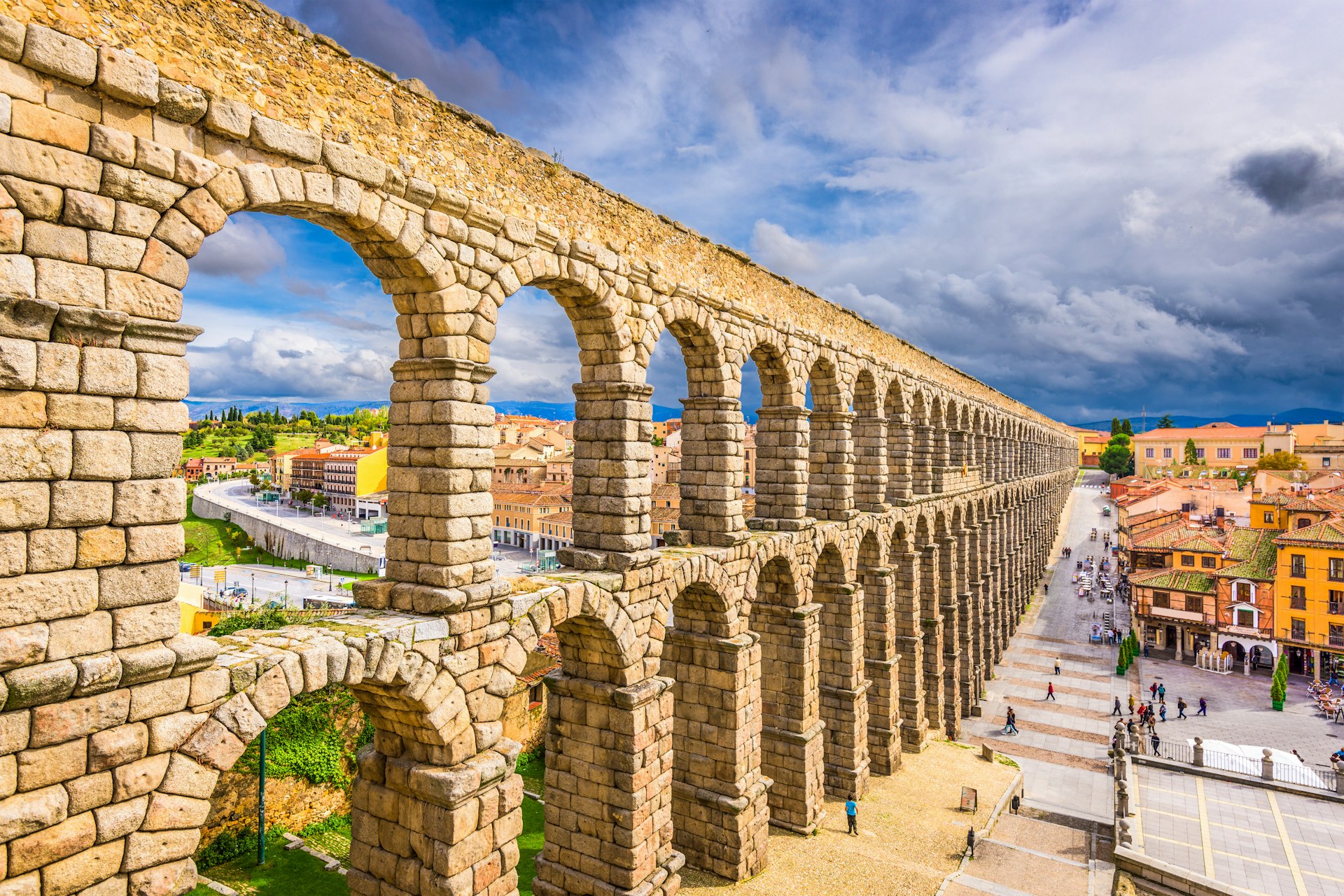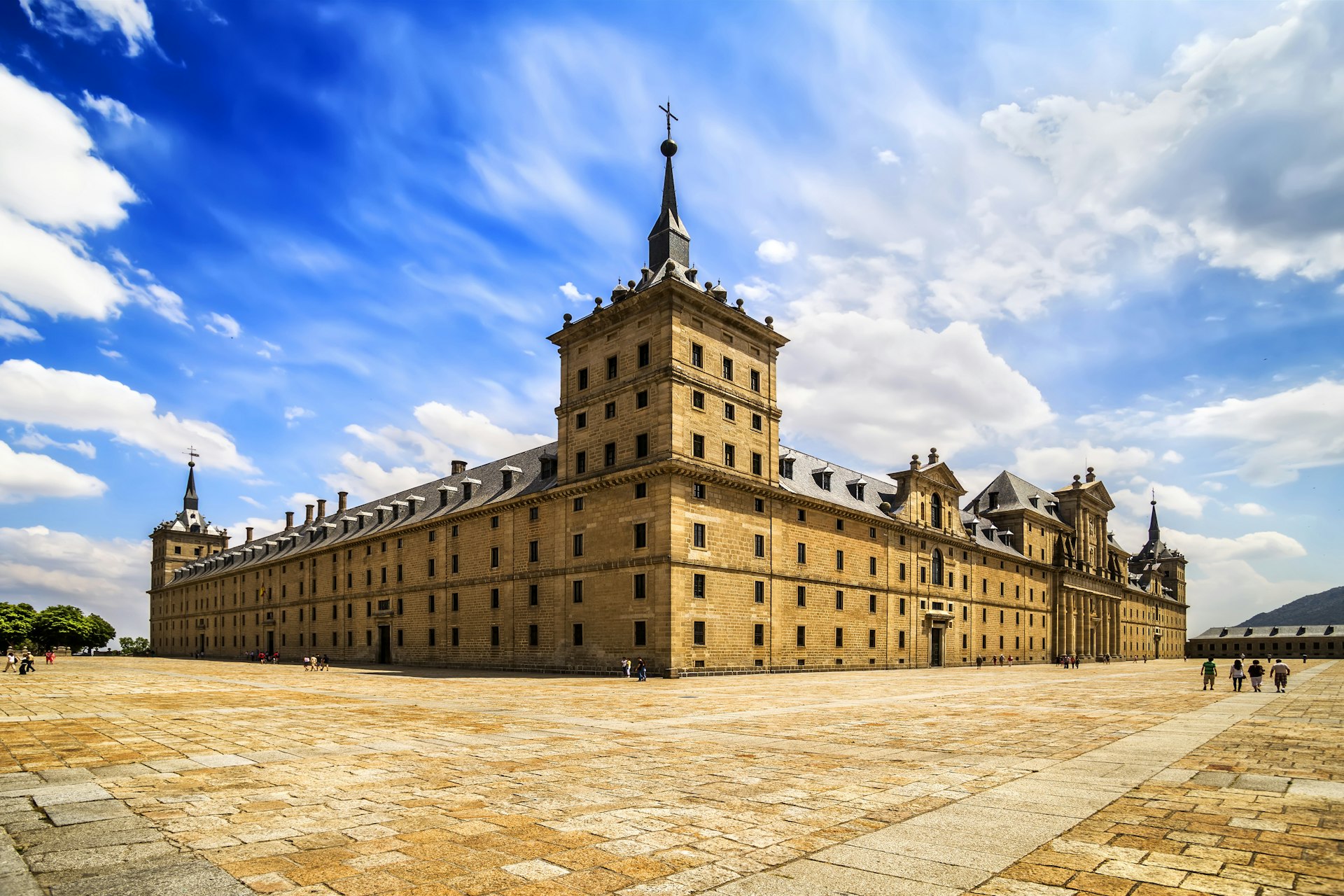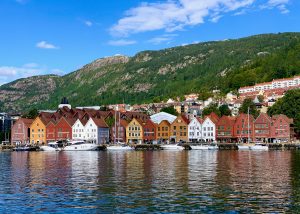
The vibrant city of Madrid is overflowing with artistic and culinary treasures, not to mention an irresistible energy of its own – we’d recommend a minimum of three days to immerse yourself in its charms.
The capital of Spain also serves as a gateway to some of the most beautiful towns and attractions anywhere in the country. There are walled cities, Roman ruins, intimate Spanish villages, and even a Unesco World Heritage-listed palace-monastery complex, all no more than an hour away. Here’s our pick of the best day excursions from Madrid.
Get the inside scoop on the latest cultural happenings all over the world delivered weekly to your inbox with our email newsletter.  See the impressive Roman aqueduct on a visit to Segovia © Sean Pavone / Shutterstock
See the impressive Roman aqueduct on a visit to Segovia © Sean Pavone / Shutterstock
1. See an impressive Roman aqueduct in Segovia
Travel time: 30 minutes
Here in Segovia, one of Spain’s single most impressive Roman monuments, El Acueducto rises over the eastern entrance to the old city. From there, busy traffic-free streets climb past Romanesque churches and pretty squares to the city’s summit and the Plaza Mayor, the heartbeat of the city that’s watched over by a 16th-century Gothic cathedral – one of the country’s finest and most formidable structures.
Continuing down the cobbled streets to the west takes you to El Alcázar, a castle said to have inspired Walt Disney’s design for Sleeping Beauty’s castle. The views from the gardens take in rolling hillsides and sandstone churches all across the Castilian countryside.
How to get to Segovia from Madrid: High-speed trains run hourly between Madrid’s Chamartin station and Segovia, taking just 28 minutes.
2. Join a fiesta in rustic Chinchón
Travel time: 50 minutes
The prettiest of all the villages within striking distance of the Spanish capital, Chinchón has at its heart an enchanted, rough-hewn town square. All roads in Chinchón lead to the rustic Plaza Mayor, a gloriously ramshackle example of Spain’s traditional village squares. Encircled by sagging balconies on wooden buildings stories high, it’s the scene for the town’s biggest fiestas and even an Easter passion play during Semana Santa (Holy Week).
How to get to Chinchón from Madrid: Chinchón is 45km (28 miles) southeast of Madrid. Take the N-IV motorway and exit onto the M404, or catch a bus from Madrid’s Avenida del Mediterráneo, 100m (328ft) east of Plaza del Conde de Casal. It takes about 50 minutes.
3. Walk the medieval walls surrounding Ávila
Travel time: 1 hour
Encircled by near-perfect city walls, Ávila is beautiful from afar and one of Spain’s more intimate urban experiences once you pass through its gates. Dating back to the 12th century, the city’s Murallas run for 2.5km (1.5 miles) with eight arched gateways, 88 watchtowers and more than 2500 turrets. You can climb the walls in places and walk along nearly 1.6km (1 mile) of their length.
From outside, the best views are from Los Cuatro Postes. Almost an extension of the city walls, the Catedral del Salvador is another extraordinary house of worship, as impressive in scale as it is exquisite in its detail. And of the many churches inside the walls, the Convento de Santa Teresa is the most storied, a pilgrimage site of great spiritual significance to Catholics everywhere.
How to get to Ávila from Madrid: Trains connect Ávila with Madrid’s Chamartin station in just over an hour.
 Hilltop Toledo is full of medieval treasures © Getty Images
Hilltop Toledo is full of medieval treasures © Getty Images
4. Explore the historic streets of Toledo
Travel time: 1 hour by car / 30 minutes by train
The walled city of Toledo is one of the most popular day-trip destinations from Madrid. Rich in Arab, Jewish and Christian history, the former Spanish capital is a Unesco World Heritage Site. Getting lost in Toledo’s tightly-knotted streets is the best way to explore it, particularly the narrow alleys around Plaza Santa Clara. But if you want a more focused itinerary, following the artwork of El Greco will bring you to some of the city’s most spectacular sites.
Head to the medieval Catedral de Toledo to see El Greco’s The Disrobing of Christ before venturing to the Museo del Greco, the only museum in Spain dedicated to the artist. The trail also leads to the Museo de Santa Cruz, where you’ll see his Sagrada Familia con Santa Ana alongside a vast collection of decorative art and ceramics. For another taste of Toledo, visit Museo Sefardí in the 14th-century Sinagoga del Tránsito to learn about the history of Jewish culture in Spain, or get an insight into Toledo’s Arab past at the Mezquita del Cristo de la Luz, which dates back to around CE 1000.
How to get to Toledo from Madrid: If driving, take the A-42 south. Alternatively, take a train from Madrid’s Atocha station. The journey takes about an hour by car and a little over 30 minutes by high-speed train.
 The elegant and vast Real Monasterio de San Lorenzo de El Escorial © Marques / Shutterstock
The elegant and vast Real Monasterio de San Lorenzo de El Escorial © Marques / Shutterstock
5. Marvel at the artworks at San Lorenzo de El Escorial
Travel time: 1 hour
In San Lorenzo de El Escorial, one of Spain’s grandest royal monuments rises from the foothills of the Sierra de Guadarrama northwest of Madrid with vast royal gardens and astonishing artworks within. The Real Monasterio de San Lorenzo de El Escorial is an extraordinary place, a vast yet supremely elegant palace-monastery filled with artworks by artists such as El Greco, Titian, Tintoretto, José de Ribera and Hieronymus Bosch; the 1576 white marble statue of a crucified Christ by Benvenuto Cellini is a sublime highpoint.
Just outside, the Jardín de los Frailes is a classic example of royal, monumental gardens, and within it lies the neo-classical, 18th-century Casita del Príncipe, a stunning little counterpoint to the sheer grandeur all around it.
How to get to San Lorenzo de El Escorial from Madrid: Renfe C8 cercanías (local trains) depart for El Escorial from Madrid’s Atocha or Chamartín train stations. Or catch a bus from platform 30 at Madrid’s Intercambiador de Autobuses de Moncloa. The journey takes about an hour.
 The Royal Palace at Aranjuez is far grander than any palaces in Madrid © cuellar / Getty Images
The Royal Palace at Aranjuez is far grander than any palaces in Madrid © cuellar / Getty Images
6. Be awed by the royal palace of Aranjuez
Travel time: 45 minutes
A royal palace and gardens in a classic (and always buzzing) Spanish provincial town – what’s not to like about Aranjuez? Far grander than any of the palaces that Madrid itself has to offer, Aranjuez’s Palacio Real was a favored pleasure retreat for Spanish royals down through the centuries, and it shows. The 300-room palace was modeled on France’s Versailles and is surrounded by expansive and perfectly manicured gardens. Museums on the grounds showcase everything from royal finery in the Casa del Labrador to the pleasure boats beloved by royals with way too much time on their hands in the Museo de Falúas.
How to get to Aranjuez: If driving, take the N-IV south, then follow the signs to the town along the M-305. Otherwise, C3 cercanías trains leave every 15 or 20 minutes for Aranjuez from Madrid’s Atocha station. The journey takes about 45 minutes.



